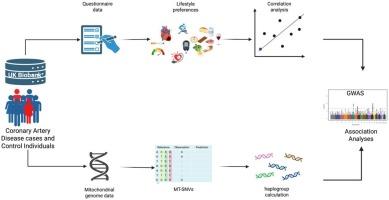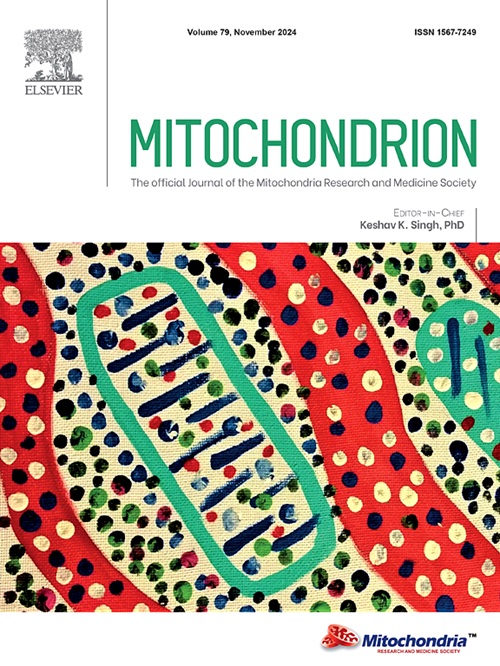使用多变量协变量和多重检验模型对线粒体DNA变异进行综合分析以提高可靠性,揭示了冠状动脉疾病特征和饮食偏好之间的潜在关联。
IF 4.5
3区 生物学
Q2 CELL BIOLOGY
引用次数: 0
摘要
冠状动脉疾病(CAD)是全球发病率和死亡率的重要组成部分。虽然全基因组关联研究已经确定了许多与CAD相关的核基因组变异,但这些变异占该疾病估计遗传力(遗传因素导致的疾病风险变异)的比例不到20% %,这表明非核遗传因素(如线粒体单核苷酸变异(mt - snv))可能起作用。mt - snv也可能影响与生活方式相关的特征,这些特征通常与调节CAD风险的遗传易感性相互作用。假设:mt - snv有助于CAD的无法解释的遗传性,也可能与生活方式行为有关。方法:我们分析了20,400例CAD(心肌梗死和/或血运重建)病例中203个高质量的常见和低频mt - snv(次要等位基因频率 > 0.01),经过严格的质量控制和imputation。mt - snv与85个定量食物摄入特征(FIQTs)和23个已确定的CAD危险因素(如吸烟状况、脂质水平、身体活动)之间的关联使用Frequentist和Bayesian方法。对这108种生活方式行为进行了相关性分析。结果:几种mt - snv名义上与CAD状态和生活习惯相关,包括m.10873T > C (MT-ND4基因)、m.15301G > A (MT-CYB基因)、m.8701A > G (MT-ATP6基因)和m.9540T > C (MT-CO3)。在调整协变量后,这些关联在统计上并不显著。结论:我们的研究结果表明,mt - snv可能解释了CAD的一些遗传性。然而,需要更大的队列和更全面的线粒体数据来阐明它们的潜在作用。本文章由计算机程序翻译,如有差异,请以英文原文为准。

Comprehensive analysis of the mitochondrial DNA variants using multivariate covariate and multiple-testing models to enhance reliability reveals potential associations with coronary artery disease traits and dietary preferences
Coronary Artery Diseases (CAD) contribute significantly to the global morbidity and mortality. While genome-wide association studies have identified numerous nuclear genomic variants linked to CAD, these account for less than 20 % of the disease’s estimated heritability (variation in disease risk attributed to genetic factors), suggesting the potential contribution of non-nuclear genetic elements, such as mitochondrial single-nucleotide variants (MT-SNVs). MT-SNVs may also influence lifestyle-related traits, which often interact with genetic predisposition to modulate CAD risk.
Hypothesis: MT-SNVs contribute to the unexplained heritability of CAD and may also be associated with lifestyle behaviours.
Methods
We analysed 203 high-quality common and low-frequency MT-SNVs (minor allele frequency > 0.01) in 20,400 CAD cases (myocardial infarction and/or revascularisation) from the UK Biobank after rigorous quality control and imputation. Associations between MT-SNVs and 85 quantitative food intake traits (FIQTs) and 23 established CAD risk factors (e.g., smoking status, lipid levels, physical activity) using both Frequentist and Bayesian methods. Correlation analyses were performed across these 108 lifestyle behaviours.
Results
Several MT-SNVs were nominally associated with the CAD status and lifestyle habits, including m.10873T > C (MT-ND4 gene), m.15301G > A (MT-CYB gene), m.8701A > G (MT-ATP6 gene), and m.9540T > C (MT-CO3). After adjusting for covariates, these associations did not remain statistically significant. CAD status was significantly but weakly correlated (|r| < 0.2) with 64 dietary preferences of the 108 lifestyle traits (Bonferroni-adjusted P < 0.05), indicating modest but widespread dietary pattern differences.
Conclusions
Our findings suggest that MT-SNVs may explain some of the CAD heritability. However, larger cohorts with more comprehensive mitochondrial data are needed to clarify their potential role.
求助全文
通过发布文献求助,成功后即可免费获取论文全文。
去求助
来源期刊

Mitochondrion
生物-细胞生物学
CiteScore
9.40
自引率
4.50%
发文量
86
审稿时长
13.6 weeks
期刊介绍:
Mitochondrion is a definitive, high profile, peer-reviewed international research journal. The scope of Mitochondrion is broad, reporting on basic science of mitochondria from all organisms and from basic research to pathology and clinical aspects of mitochondrial diseases. The journal welcomes original contributions from investigators working in diverse sub-disciplines such as evolution, biophysics, biochemistry, molecular and cell biology, genetics, pharmacology, toxicology, forensic science, programmed cell death, aging, cancer and clinical features of mitochondrial diseases.
 求助内容:
求助内容: 应助结果提醒方式:
应助结果提醒方式:


